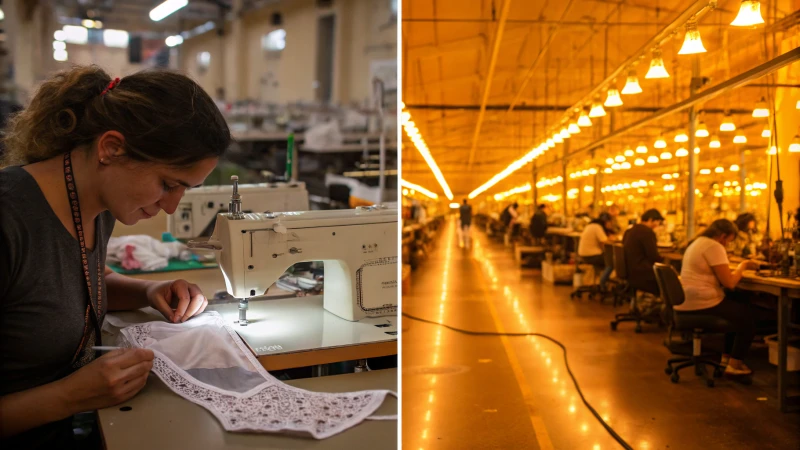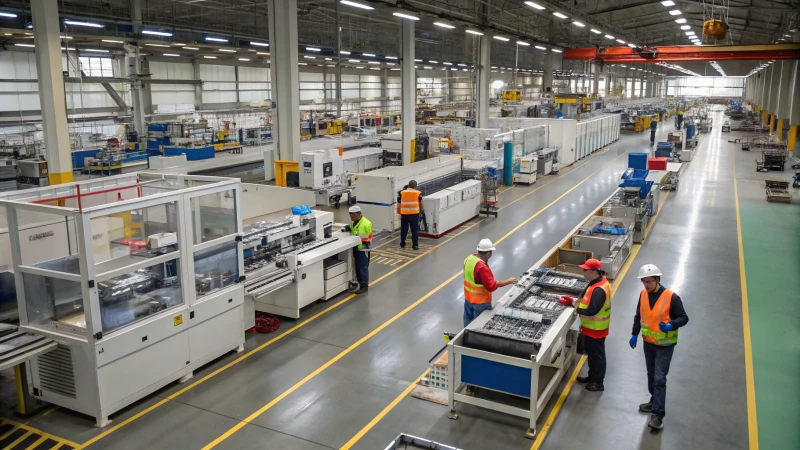
So, you’re diving into the world of custom underwear, and now you’re stuck deciding between small and large-scale manufacturers?
Choosing between small and large-scale custom underwear manufacturers boils down to production capacity, lead time, quality control, and cost. Small manufacturers offer personalized service and flexibility, while large ones provide cost efficiency and consistent quality for bulk orders.
While these basic differences are crucial, your specific needs might sway your decision more than you'd expect. I remember when I first started my business, I was torn. On one hand, the personal touch of a small manufacturer seemed appealing. They promised a level of detail and craftsmanship that felt like a perfect fit for my brand's identity. But then, the efficiency and competitive pricing of larger manufacturers made me think twice.
It’s like choosing between a cozy mom-and-pop cafe with the best homemade pie or a bustling coffee chain that ensures my caffeine fix is just a tap away—both have their perks. As I dug deeper into my business goals, it became clear which path aligned better with what I envisioned for my brand. So, take a moment to reflect on what truly matters to you: is it the personalized experience or the robust capability to scale up? Your answer will guide you through this pivotal choice.
Small manufacturers offer more personalized service.True
Small manufacturers can cater to individual needs, providing tailored services.
Large manufacturers lack quality control in bulk orders.False
Large manufacturers often have strict quality control to maintain standards.
How Does Production Capacity Affect Your Choice?
Navigating the maze of manufacturing options? Production capacity is your guiding star, shaping everything from speed to quality and cost.
Production capacity shapes decisions by setting the pace and efficiency of manufacturing. It affects costs, quality, and adaptability, influencing whether to choose small-scale or large-scale manufacturing options.

Understanding Production Capacity
When I first started exploring manufacturers, the concept of production capacity was like a hidden key to unlocking successful partnerships. It refers to the maximum output a company can churn out within a certain timeframe. Imagine walking into a bustling factory—it's not just about the machines; it's about the people and materials that turn raw ideas into reality. Here’s a quick snapshot:
| Factors | Small Manufacturer | Large Manufacturer |
|---|---|---|
| Machines Available | Limited | Extensive |
| Labor Force | Specialized | Broad |
| Material Availability | Custom orders | Bulk orders |
Impact on Lead Time and Flexibility
The first time I had to meet a tight deadline for a custom order, I realized how much production capacity affects lead time. Smaller manufacturers often handle fewer orders, offering a nimbleness that's perfect when you need last-minute tweaks—like when I needed a rush on those customized products1 for a client. Meanwhile, larger manufacturers march to the drum of bulk production, which can mean longer waits but also reliability for steady demand.
Quality Control Considerations
Quality was non-negotiable for me, and I found that smaller manufacturers were artisans in their own right. Their focus on craftsmanship2 and detail often leads to higher-quality products, which was crucial when my brand's reputation was on the line. On the flip side, larger manufacturers excel at consistency—ideal when uniformity trumps finesse.
Cost Implications
Navigating costs felt like balancing on a tightrope. Small manufacturers tended to have higher unit costs but offered extensive customization—perfect for when uniqueness was key. Conversely, large manufacturers leverage economies of scale, giving competitive pricing that suited bulk orders without breaking the bank.
| Manufacturer Type | Unit Cost | Customization Options |
|---|---|---|
| Small | High | Extensive |
| Large | Low | Limited |
Strategic Decision-Making
In the end, choosing between small-scale and large-scale production felt like mapping out a strategy game. I had to weigh my order volume3, desire for customization, and budget against the backdrop of my business goals. Whether it was opting for the agile customization of small manufacturers or the cost-effectiveness of large-scale operations, aligning production capacity with strategy became a pivotal part of my decision-making process.
Small manufacturers offer shorter lead times.True
They handle fewer orders, allowing for quick adjustments and flexibility.
Large manufacturers provide more customization options.False
Large manufacturers focus on bulk production, limiting customization choices.
Why Is Lead Time and Flexibility Important?
Have you ever wondered why some businesses seem to effortlessly adapt to change while others struggle?
Lead time and flexibility are vital because they allow businesses to swiftly meet customer needs and adapt to market fluctuations. By shortening lead times, companies enhance customer satisfaction, while maintaining flexibility ensures they can navigate unexpected changes.

Understanding Lead Time
Imagine you're waiting for a much-anticipated package. The wait seems endless, right? That's where lead time comes into play—it's that gap between when an order is placed and when it's fulfilled. In fast-moving industries like fashion4, where trends evolve quicker than a heartbeat, having shorter lead times is crucial. I remember a time when I was working on a fashion project, and the pressure to hit deadlines was intense. We had to streamline processes, use advanced tech, and improve our supply chain efficiency just to keep up.
Lead Time Reduction Techniques:
- Streamlining processes
- Utilizing advanced technologies
- Improving supply chain efficiency
The Role of Flexibility in Business
Flexibility is like having a secret superpower in business. It's about adapting to change—whether it's a sudden spike in demand or a shift in market trends. Think about how exciting it is when you can turn challenges into opportunities! During my career, there was an instance when a supplier couldn't deliver on time, and we had to pivot quickly, finding new ways to keep everything on track. That experience taught me the value of being adaptable, which not only keeps customers happy but also boosts competitiveness.
Examples of Flexibility in Action:
| Scenario | Flexible Response |
|---|---|
| Sudden increase in demand | Scaling up production quickly |
| Supply chain disruption | Switching suppliers or modes of transport |
| Change in regulatory requirements | Adjusting processes to comply rapidly |
Balancing Lead Time and Flexibility
Striking the perfect balance between lead time and flexibility is like walking a tightrope. I’ve learned that while speed is essential, adaptability is equally critical. Companies that master this balance often outshine their rivals. Integrating smart logistics5 solutions is one way I've seen businesses optimize both factors simultaneously.
Key Strategies:
- Investing in technology that enables real-time data analysis
- Training workforce for multi-skilled tasks
- Building a versatile supply chain network
These strategies not only boost operational efficiency but also prepare businesses for the uncertainties of today’s world. Understanding the importance of lead time and flexibility is crucial for long-term success. Looking back at my own experiences, I realize how these elements have been game-changers in achieving business goals.
Shorter lead times improve customer satisfaction.True
Quicker delivery meets customer expectations, enhancing satisfaction.
Flexibility reduces a company's competitiveness.False
Flexibility increases adaptability, boosting competitiveness and loyalty.
How Do Quality Control Approaches Differ Between Small and Large Manufacturers?
Diving into the world of quality control can be quite the adventure! Whether you're crafting by hand or running a big operation, understanding these differences is key to success.
Quality control (QC) differences lie in focus and execution. Smaller manufacturers cherish craftsmanship and detail, while larger ones emphasize uniformity and efficiency, shaping product quality and customization levels.

Focus on Craftsmanship vs. Consistency
When I first started exploring the ins and outs of small-scale manufacturing6, I was blown away by how much heart goes into every product. Small manufacturers have the luxury to infuse each item with a personal touch, focusing on craftsmanship that truly showcases an artisan's flair.
On the flip side, I remember touring a large-scale operation7 where the emphasis was all about keeping things consistent. It was fascinating to see how they achieved such uniformity across thousands of units. Their processes are a well-oiled machine designed to ensure every product meets the same high standards.
Customization and Flexibility
One of the things that caught my eye with small manufacturers is their knack for customization. They can tweak and tailor products to meet unique customer needs, which I find incredibly valuable. This adaptability extends to their quality control practices, allowing for those last-minute custom touches.
However, in larger manufacturing settings, I noticed that while they excel at producing in bulk efficiently, their structured QC systems can sometimes limit flexibility. Speed and cost-effectiveness are prioritized, but this can occasionally mean sacrificing personalization.
| Manufacturer Type | QC Focus | Flexibility |
|---|---|---|
| Small | Detail | High |
| Large | Consistency | Low |
Tools and Technology
When it comes to tools and technology, the contrast is striking. Small manufacturers often stick to tried-and-true methods, relying on human inspection to capture the essence of craftsmanship. This personal touch really shines through in their products.
Larger manufacturers tend to invest heavily in technology—think AI-driven inspections and automated testing. These tools help them maintain a high throughput without compromising on quality. I once saw automation in QC8 in action—it’s a marvel of precision but comes with hefty investments.
Cost Implications
The choice between these approaches also affects costs. Small manufacturers usually face higher unit costs due to labor-intensive quality checks. However, this investment often translates into unique, high-quality products.
In contrast, large companies leverage economies of scale to keep expenses down. They offer competitive pricing for bulk orders but might miss out on those intricate details that make each product special.
Deciding between these options depends on what matters most for your business—whether it's quality, cost, or customization.
Small manufacturers focus on craftsmanship in QC.True
Small-scale operations emphasize artisan skills and detail in quality checks.
Large manufacturers offer high customization in QC.False
Large operations prioritize consistency over customization due to structured systems.
How Do Cost and Pricing Influence Your Decision?
Have you ever stood in a store, heart racing as you weighed the cost versus your budget? Pricing can sway our decisions more than we realize.
Cost and pricing shape our choices by influencing perceived value and urgency. Low prices suggest bargains, while high ones imply quality. Balancing budget and perceived value is key.

The Psychology Behind Pricing
Let's dive into the fascinating world of pricing psychology. Have you ever noticed how a price ending in ".99" feels like a steal? This isn't just a coincidence—it's called charm pricing. I remember grabbing a shirt because it was marked at $19.99 instead of $20, feeling like I'd outsmarted the system. It's funny how such small differences can make us feel like savvy shoppers.
Understanding pricing psychology9 can help you make more informed choices.
| Pricing Strategy | Effect on Consumer Behavior |
|---|---|
| Charm Pricing | Perceived as cheaper |
| Prestige Pricing | Suggests luxury and exclusivity |
| Anchor Pricing | Sets a reference point for comparison |
Cost vs. Perceived Value
We've all been there—holding an item, pondering if its higher price tag means better quality. Once, I splurged on a designer jacket thinking it would last forever, only to find myself disappointed when it didn't live up to the hype. It's important to evaluate the true value of what we're buying. By digging into perceived value10, we can avoid these costly mistakes.
Influence on Budget Constraints
Sticking to a budget is like trying to stay on a diet—challenging but rewarding. Finding a product that fits within my budget always brings a sense of relief and accomplishment. Conversely, overspending often leads to regret, like that time I stretched my budget for a gadget that quickly lost its novelty. Balancing costs with needs is essential for effective budgeting11.
Urgency and Scarcity
Ever felt the rush of a "limited-time offer"? It's like that Black Friday shopping frenzy where I grabbed things just because the deal seemed too good to pass up. This urgency can lead to impulsive choices. Recognizing these tactics helps me keep my cool and make more rational decisions.
Tip: Always compare multiple products and read reviews before deciding to ensure you're getting the best deal for your money.
Understanding these dynamics empowers me to make smarter choices, optimizing value without compromising on quality or blowing my budget.
Charm pricing makes products appear more affordable.True
Prices ending in .99 are perceived as cheaper, influencing buying decisions.
Higher cost always equals higher quality.False
Price doesn't always reflect quality; assess features and benefits for value.
Conclusion
Choosing between small and large-scale custom underwear manufacturers involves considering production capacity, lead time, quality control, and cost to align with your business needs.
Understand how a manufacturer's capacity influences the flexibility of product customization. ↩
Discover the benefits of detailed craftsmanship that smaller manufacturers can offer. ↩
Gain insights into evaluating your order volume to make informed manufacturing choices. ↩
This link offers insights into how reduced lead times can benefit the fashion industry, ensuring businesses keep up with ever-changing trends. ↩
Learn about smart logistics systems that help manage lead time and flexibility effectively, boosting operational efficiency. ↩
Explore how small-scale manufacturers prioritize craftsmanship and detail in their quality control processes. ↩
Learn about the importance of consistency in quality control for large-scale manufacturers. ↩
Discover how automation enhances precision and efficiency in large-scale quality control processes. ↩
Explore how pricing strategies like charm pricing affect consumer behavior, helping you understand why certain prices attract you more. ↩
Learn how to assess the true value of products beyond their price tags, enabling better purchasing decisions. ↩
Discover practical tips for maintaining a budget while shopping, ensuring that you spend wisely without overspending. ↩






